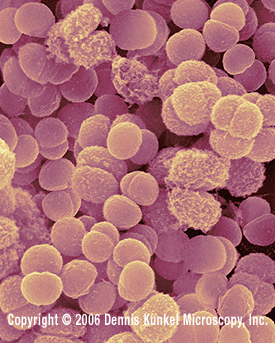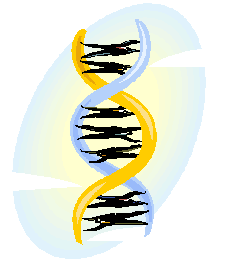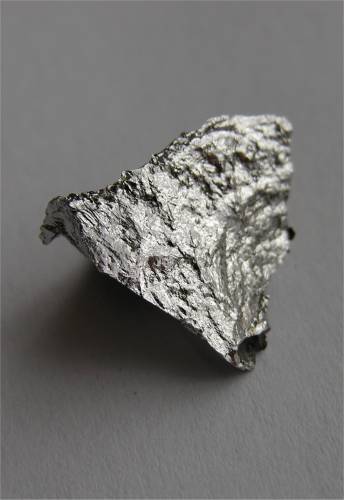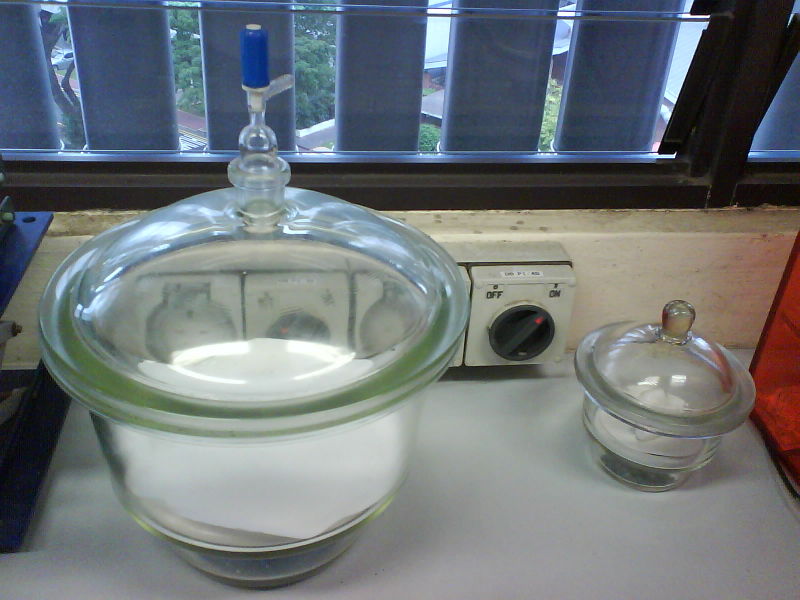What's All The Fuss About?
Deinococcus radiodurans is infamous for its resistance to high levels of radiation and long periods of desiccation. Upon learning of D.radiodurans' viability, it was surprising to find that it does not produce a spore. Its mechanisms of surviving utilize a different mechanism of resistance.
Which Came First, the Chicken Or the Egg?
It was particularly
perplexing to consider
how D. radiodurans evolved such a strong resistance to radiation. The average level of naturally occurring radiation measured on Earth is 5x10-8
Gy per hour, compared to the 5,000 Gy that D. radiodurans can
survive without a loss of viability. It is thought instead, the radiation
resistance is a byproduct of D. radiodurans' tolerance to
desiccation. It turns out that prolonged exposure to extremely dry
conditions causes double stranded DNA breaks, similar to those caused by
radiation. In developing a mechanism to combat desiccation, it also
developed a way to cope with the effects of ionizing radiation. A study
completed by John Battista and Valerie Mattimore published in 1996 tested 41 strains of radiation
sensitive Deinococcus radiodurans mutants and discovered that all of
the strains were also sensitive to desiccation.
such a strong resistance to radiation. The average level of naturally occurring radiation measured on Earth is 5x10-8
Gy per hour, compared to the 5,000 Gy that D. radiodurans can
survive without a loss of viability. It is thought instead, the radiation
resistance is a byproduct of D. radiodurans' tolerance to
desiccation. It turns out that prolonged exposure to extremely dry
conditions causes double stranded DNA breaks, similar to those caused by
radiation. In developing a mechanism to combat desiccation, it also
developed a way to cope with the effects of ionizing radiation. A study
completed by John Battista and Valerie Mattimore published in 1996 tested 41 strains of radiation
sensitive Deinococcus radiodurans mutants and discovered that all of
the strains were also sensitive to desiccation.
DNA
It is estimated that each cell of
D. radiodu rans contains approximately four copies of its genetic
material. The genome is contained in a circular chromosome that condenses
to a ring structure compared to other bacteria that have their DNA scattered
throughout the cell.
Previously, it was thought that the key to radiation resistance was in the DNA.
However, recent research has revealed that the key does not lie in the DNA but
in the ability to maintain the proteins in the cell instead. Now, they
believe that extra copies of DNA serve as reservoir of genetic information
instead of the main player in the mechanism.
rans contains approximately four copies of its genetic
material. The genome is contained in a circular chromosome that condenses
to a ring structure compared to other bacteria that have their DNA scattered
throughout the cell.
Previously, it was thought that the key to radiation resistance was in the DNA.
However, recent research has revealed that the key does not lie in the DNA but
in the ability to maintain the proteins in the cell instead. Now, they
believe that extra copies of DNA serve as reservoir of genetic information
instead of the main player in the mechanism.
Well If It's Not DNA What Is It?
Instead current research
indicates that the key to r adiation resistance is due to the presence of the
manganese II cation which is in particularly high concentrations in the cells of
D. radiodurans. This cation acts to oxidize species such as free
radicals. It also acts as a unique cofactor in the ligase enzymes, an
enzyme that repairs DNA. In one experiment, they added manganese ions to
the cells of Eschericia coli and found that it increased the cells
viability when exposed to radiation. Even though it is still in question what role the manganese ion
plays, it is certainly important.
adiation resistance is due to the presence of the
manganese II cation which is in particularly high concentrations in the cells of
D. radiodurans. This cation acts to oxidize species such as free
radicals. It also acts as a unique cofactor in the ligase enzymes, an
enzyme that repairs DNA. In one experiment, they added manganese ions to
the cells of Eschericia coli and found that it increased the cells
viability when exposed to radiation. Even though it is still in question what role the manganese ion
plays, it is certainly important.
The Big Picture
It is thought that in the case of both radiation and desiccation, the organism acquires double stranded breaks like any other organism. D. radiodurans does not protect its DNA but its proteins. By protecting the proteins, it enables the bacteria to fix its DNA efficiently and grow in the presence of ionizing radiation.
Woa... That's some pretty cool stuff but what can this adaptation do for YOU?

